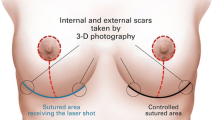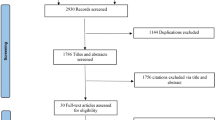Abstract
Scars resulting from deliberate self-harm (DSH) represent therapeutically challenging forms of scarring due to their highly variable patterns, with no official therapeutic guidelines available. In this pilot study, we aimed to evaluate the effectiveness and safety of a non-ablative fractional Er:glass 1565 nm laser, as a potential new, minimal-invasive approach for the improvement of DSH scars. Sixteen Caucasians suffering from mature DSH scars were included in this clinical study. Patients received a total of three treatments using a non-ablative fractional 1565 nm Er:glass laser every 4 weeks, employing two passes (300 μbeams/cm2, 40 mJ, onto the scar; 150 μbeams/cm2, 50 mJ, overall area). Measurements included questionnaires (DLQI, POSAS), digital photography, and objective three-dimensional analysis using PRIMOS and VECTRA software at baseline, 1 and 6 months after treatment. PRIMOS objective measurements showed highly significant changes in scar surface with a reduction of atrophic lesions by 27.5% at 6 months follow-up (FU), a decrease in scar height by 42.7% at 6 months FU, resulting in an overall diminished skin irregularity dropping from 678.3 μm at baseline to 441.6 μm throughout the course of the study (p = <0.001 respectively). Improvements in objective measurements were supported by clinical evaluation of scar parameters and showed a strong correlation with enhanced life quality of treated patients. Procedures were well-tolerated, with no lasting negative side effects and little to no downtime. The use of a fractional non-ablative 1565 nm Er:glass laser represents a promising and safe approach for the therapy of DSH scars. Although these scars will never fully resolve, their appearance can be significantly improved to a cosmetically and socially more acceptable appearance.





Similar content being viewed by others
References
Greydanus DE, Apple RW (2011) The relationship between deliberate self-harm behavior, body dissatisfaction, and suicide in adolescents: current concepts. J Multidiscip Healthc 4:183–189
Scoliers G, Portzky G, Madge N, Hewitt A, Hawton K, de Wilde EJ, Ystgaard M, Arensman E, De Leo D, Fekete S, van Heeringen K (2009) Reasons for adolescent deliberate self-harm: a cry of pain and/or a cry for help? Findings from the child and adolescent self-harm in Europe (CASE) study. Soc Psychiatry Psychiatr Epidemiol 44(8):601–607
Lauw M, How CH, Loh C (2015) Authors’ reply: deliberate self-harm in adolescents. Singap Med J 56(9):531
Greydanus DE, Shek D (2009) Deliberate self-harm and suicide in adolescents. Keio J Med 58(3):144–151
Poetschke J, Gauglitz GG (2016) Current options for the treatment of pathological scarring. J Dtsch Dermatol Ges 14(5):467–477
Heppt MV, Breuninger H, Reinholz M, Feller-Heppt G, Ruzicka T, Gauglitz GG (2015) Current strategies in the treatment of scars and keloids. Facial Plast Surg 31(4):386–395
Brown BC, McKenna SP, Siddhi K, McGrouther DA, Bayat A (2008) The hidden cost of skin scars: quality of life after skin scarring. J Plast Reconstr Aesthet Surg 61(9):1049–1058
Reinholz M, Poetschke J, Schwaiger H, Epple A, Ruzicka T, Gauglitz GG (2015) The dermatology life quality index as a means to assess life quality in patients with different scar types. J Eur Acad Dermatol Venereol
Nast A, Eming S, Fluhr J, Fritz K, Gauglitz G, Hohenleutner S, Panizzon RG, Sebastian G, Sporbeck B, Koller J, German Society of D (2012) German S2k guidelines for the therapy of pathological scars (hypertrophic scars and keloids). J Dtsch Dermatol Ges 10(10):747–762
Gold MH, McGuire M, Mustoe TA, Pusic A, Sachdev M, Waibel J, Murcia C, International Advisory Panel on Scar M (2014) Updated international clinical recommendations on scar management: part 2—algorithms for scar prevention and treatment. Dermatologic Surg 40(8):825–831
Gold MH, Berman B, Clementoni MT, Gauglitz GG, Nahai F, Murcia C (2014) Updated international clinical recommendations on scar management: part 1—evaluating the evidence. Dermatol Surg 40(8):817–824
Ismail A, Jarvi K, Canal AC (2008) Successful resurfacing of scars from previous deliberate self-harm using Integra dermal matrix substitute. J Plast Reconstr Aesthet Surg 61(7):839–841
Todd J, Ud-Din S, Bayat A (2012) Extensive self-harm scarring: successful treatment with simultaneous use of a single layer skin substitute and split-thickness skin graft. Eplasty 12:e23
Bonati LM, Epstein GK, Strugar TL (2017) Microneedling in all skin types: a Review. J Drugs Dermatol 16(4):308–313
Borges J, Manela-Azulay M, Cuzzi T (2016) Photoaging and the clinical utility of fractional laser. Clin Cosmet Investig Dermatol 9:107–114
Draaijers LJ, Tempelman FR, Botman YA, Tuinebreijer WE, Middelkoop E, Kreis RW, van Zuijlen PP (2004) The patient and observer scar assessment scale: a reliable and feasible tool for scar evaluation. Plast Reconstr Surg 113(7):1960–1965 discussion 6–7
Poetschke J, Dornseifer U, Clementoni MT, Reinholz M, Schwaiger H, Steckmeier S, Ruzicka T, Gauglitz GG (2017) Ultrapulsed fractional ablative carbon dioxide laser treatment of hypertrophic burn scars: evaluation of an in-patient controlled, standardized treatment approach. Lasers Med Sci 32(5):1031–1040
Reinholz M, Poetschke J, Schwaiger H, Epple A, Ruzicka T, Gauglitz GG (2015) The dermatology life quality index as a means to assess life quality in patients with different scar types. J Eur Acad Dermatol Venereol 29(11):2112–2119
Spanholtz TA, Leitsch S, Holzbach T, Volkmer E, Engelhardt T, Giunta RE (2012) 3-dimensional imaging systems: first experience in planning and documentation of plastic surgery procedures. Handchir Mikrochir Plast Chir 44(4):234–239
Tretti Clementoni M, Lavagno R (2015) A novel 1565 nm non-ablative fractional device for stretch marks: a preliminary report. J Cosmet Laser Ther 17(3):148–155
Lee Y (2009) Combination treatment of surgical, post-traumatic and post-herpetic scars with ablative lasers followed by fractional laser and non-ablative laser in Asians. Lasers Surg Med 41(2):131–140
Friedmann DP, Tzu JE, Kauvar AN, Goldman MP (2016) Treatment of facial photodamage and rhytides using a novel 1,565 nm non-ablative fractional erbium-doped fiber laser. Lasers Surg Med 48(2):174–180
Shin MK, Choi JH, Ahn SB, Lee MH (2014) Histologic comparison of microscopic treatment zones induced by fractional lasers and radiofrequency. J Cosmet Laser Ther 16(6):317–323
Kim BJ, Lee DH, Kim MN, Song KY, Cho WI, Lee CK, Kim JY, Kwon OS (2008) Fractional photothermolysis for the treatment of striae distensae in Asian skin. Am J Clin Dermatol 9(1):33–37
Hantash BM, Bedi VP, Struck SK, Chan KF (2010) Immunohistochemical evaluation of the heat shock response to nonablative fractional resurfacing. J Biomed Opt 15(6):068002
Weng Y, Dang Y, Ye X, Liu N, Zhang Z, Ren Q (2011) Investigation of irradiation by different nonablative lasers on primary cultured skin fibroblasts. Clin Exp Dermatol 36(6):655–660
Starnes AM, Jou PC, Molitoris JK, Lam M, Baron ED, Garcia-Zuazaga J (2012) Acute effects of fractional laser on photo-aged skin. Dermatologic Surg 38(1):51–57
Author information
Authors and Affiliations
Contributions
AG performed measurements, collected and evaluated study data and wrote the manuscript; MR performed treatments and helped designing the study outline; JP helped obtaining data; HS helped collecting data; GGG wrote the manuscript and designed the study outline.
Corresponding author
Ethics declarations
Conflict of interest
GGG serves as speaker and advisor for Lumenis. AG, MR, JP, SS declare no conflict of interest.
Rights and permissions
About this article
Cite this article
Guertler, A., Reinholz, M., Poetschke, J. et al. Objective evaluation of the efficacy of a non-ablative fractional 1565 nm laser for the treatment of deliberate self-harm scars. Lasers Med Sci 33, 241–250 (2018). https://doi.org/10.1007/s10103-017-2348-x
Received:
Accepted:
Published:
Issue Date:
DOI: https://doi.org/10.1007/s10103-017-2348-x




